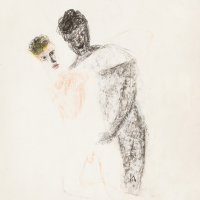24. SIDNEY NOLAN

With Gallipoli, Nolan continues his quest for a possible interaction between history and geography, and between imagination and reality. The theme is a great one and means much to the artist, The paintings, so far, evoke wonderfully well the light and atmosphere of the place, shimmering in heat, with bodies seeming to float in space.1
Pamela Hansford Johnson, the English author, was entranced by her first encounter with the paintings of Sidney Nolan. Her husband, the noted writer C. P. (Lord) Snow, illustrated his covers with Nolans pictures, but it is from Johnson that we garner these first responses: one day, going into Redfern Galleries in Cork Street, I was struck with excitement. Here was an Australian painter, Sidney Nolan, whose name I did not know at all, few in England did at that time I called Charles in to see them at once: and we bought, for a sum Kelly 1954 [sic].2 Johnson continues:
Since then, we were able to acquire, in those early days, a Leda, a magnificent painting of a dead soldier on the beaches of Gallipoli [our present lot]; and a mysterious, sea-borne painting of Ayers Rock, which is a thousand miles from any sea. Two of his paintings he has lent us, for as long as he wishes us to keep them.3
The reminiscence vividly brings to life the artistic milieu of 50s London. Pamela Hansford Johnson became Nolans firm friend and patron. Lindsay Avebury, her daughter, remembers Nolan coming to my parents' flat in the Cromwell Road, London SW5 and I met him there several times. He also came to a party or maybe several at that flat.4 Nolan was a great collector of themes as he was of the people in his world. With his curious mind and his poetic stance, Nolan had many admirers and by the end of the 1950s, a burgeoning critical reputation.
This connection is also made to Nolans drawing, The Unspeakable Leda 1959 (lot 24) which he dedicated to Pamela Hansford Johnson. It is an illustrative, erotic response to Johnsons comic novel, The Unspeakable Skipton. Daniel Skipton is struggling to publish his second novel, a masterpiece by his own reckoning. Skipton lives in Bruges, getting by, writing for small publications, and beguiling English tourists towards poor Flemish art, and dubious sexual encounters.
When Nolan worked on any new theme, the artist would be intensely occupied with paintings end to end in the studio. Images would drop in as it were to be brought to life on both board and paper. In material terms, the Nolan Leda series prefigures the Gallipoli paintings by the use of polyvinyl acetate on composition board and technique - the putting on and scraping back of paint. The impetus for Gallipoli was Hydra where Nolan and his wife Cynthia had gone to live in 1955. Nolans imagination was fired by reading Homers Iliad and Robert Graves Greek Mythology. George Johnstone, the Australian writer then living on Hydra, introduced Nolan to Alan Mooreheads history of the Gallipoli campaign. This deepened Nolans research. He understood how Gallipoli, in its tragic formation, could be transposed to the mythology and iconography of Homers world. The Arthur Adams poem, The Trojan War 1915, best describes Nolans thinking:
Homeric wars are fought again
By men who like old Greeks can die;
Australian backblock heroes slain,
With Hector and Achilles lie.5
The Dead Soldier on the Shores of Gallipoli c1960 appears at peace. He lies idealised and separate from battle, an archaic figure. His prone body is distended, but it is the nonchalant pose, the crossed legs, and the restful face, that are the pathos of Dead Soldier. The faces of Nolans soldiers are often boyish, with an innocent cast that belies the horror of war. They portray soldiers, often Nolans friends, and are also, by his own admission, the many faces of his brother Raymond, who died tragically after returning from military service. Dead Soldier on the Shores of Gallipoli is a remembrance and a valediction, at waters edge, to the fallen soldier. Nolans placement of the figure is artful, but it is the hills and the air that give the painting its piquancy.
Footnotes:
1. Robertson, B., in Sidney Nolan, Thames & Hudson, London, 1961, p.178
2. Kelly 1955, Ripolin enamel on board, 81.5 x 100.0 cm; sold Sothebys Melbourne, 26 April 1999, lot 98, $838,500 (including buyers premium)
3. Johnson, P., Important to Me: Personalia, Macmillan Publishing, London, 1974, p.32
4. Lindsay (Lady) Avebury in conversation with the author, January 2023
5. Adams, A., The Trojan War 1915, quoted in Fry, G., Nolans Gallipoli, Rigby Publishers, Sydney, 1983, p.13
Brett Ballard